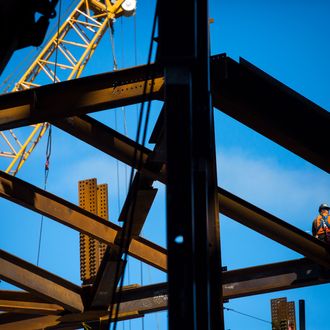
If you’re confused about how, exactly, Bill de Blasio plans to make New York a cheaper place to live, you’re in good company: pretty much the city’s entire (growing) population, minus (perhaps) a handful of zoning nerds, are too, even as the Department of City Planning is out explaining it to community boards. The mayor’s simple goal comes wrapped in such mesmerizingly dull and sometimes conflicting regulations that it’s tempting to let the lawyers work it out. And yet the minutiae matter to everyone because they affect the texture of the city: how hard you have to work to pay the rent, how far you have to go for groceries and how sunny the walk is, whether old and young people inhabit the same blocks.
The de Blasio housing plan has three major parts, two of which are sweeping, worthy changes; the third hides a clunker in a welter of good intentions. For starters, the administration would rewrite the zoning for selected swaths of the city—including East New York and East Harlem—to prod developers into building many more apartments. Then it would establish the principle that in all newly rezoned areas, any new residential buildings must include at least 25 percent rent-regulated apartments. That’s called Mandatory Inclusionary Zoning. These are two good, if imperfect tools. Residents of East Harlem justifiably fear that if developers get to put up expensive new towers, the number of new affordable apartments they include would be dwarfed by the old ones lost to teardowns, evictions, and rent hikes. And yet the alternative is to build no new housing at all and watch prices keep shooting skywards.
The third prong of the mayor’s plan fills out a bureaucratic page-turner of a document called Zoning for Quality and Affordability, or ZQA, which tries to accomplish so many arcane goals that it has a tendency to anger opponents for all the wrong reasons. Its core is an effort to tweak the rules in so-called contextual zoning districts, architecturally uniform neighborhoods where the law protects against big, garish interlopers. Much of New York is an ungoverned hodgepodge of styles and sizes, but in contextual districts, rules control how tall a building can be, how it meets the sidewalk, how steeply the roof is pitched, and how many apartments it contains. That’s why you can’t build a glassy high-rise in the heart of Park Slope. Contextual zoning, first introduced nearly 30 years ago, is not a one-size-fits-all regulation; rather, it’s the product of block-by-block skirmishes, and the veterans of those battles are especially adamant that it should remain untouched.
The Department of City Planning is hoping to reopen contextual zoning in order to excise a range of unintended consequences. It would, for example, remove restrictions that preclude new buildings from having bay windows. ZQA would also allow an extra five feet of height to the ground floor of all new buildings, making it possible to include steps, stoops, and storefronts just high-ceilinged enough to accommodate a small business, like a barber shop. (The provision effectively excludes big chain stores, which require considerably more clearance.) The proposal also grants some extra height to 100-percent affordable senior residences. This makes sense: surely contextual districts can tolerate a few extra stories if it means we don’t have to exile the elderly to isolated suburban estates.
ZQA’s most troubling intrusion into contextual districts is a provision that would permit up to four extra stories for so called 80-20 buildings—projects that include some affordable apartments in otherwise full-priced fancy towers. City Planning does have a rationale for this giveaway: as it stands, developers who take advantage of the program theoretically get to cram in an extra chunk of square footage, but they can’t raise the roof to accommodate it. It’s like making an official basketball bigger than the hoop: two points if you get it through, and good luck trying.
But the administration’s proposal fails to solve one problem while creating another, instead. ZQA would likely add a marginal amount of affordable housing to the city’s stock—ten apartments here, a dozen there—but it would erode the very qualities that contextual zoning was designed to preserve. In other words, those neighborhoods will get crappier without getting any cheaper.
De Blasio’s housing plan is an unwieldy tool, most of it is worth trying anyway. Mass rezonings, obligatory affordable housing, lower parking quotas, looser street-level restrictions, breaks for senior residences—all these moves may well perform as advertised. But he avoids doing what the current real-estate market could allow him to, at least in many of the city’s more desirable neighborhoods: force developers to fold more affordable housing into their pricey new buildings. The mayor has decided that tactic would be counterproductive. Instead, he’s offering developers a new bribe so that they will take the old one. No wonder the real estate industry is so happy these days.
Related:
Hunters Point South Should Be the New Gold Standard for Affordable Housing
Which New York Is Yours? A Fierce Preservationist and a Pro-Development Blogger Debate
New York’s Next Great Political Battle Will Be a Railyard in Queens






























